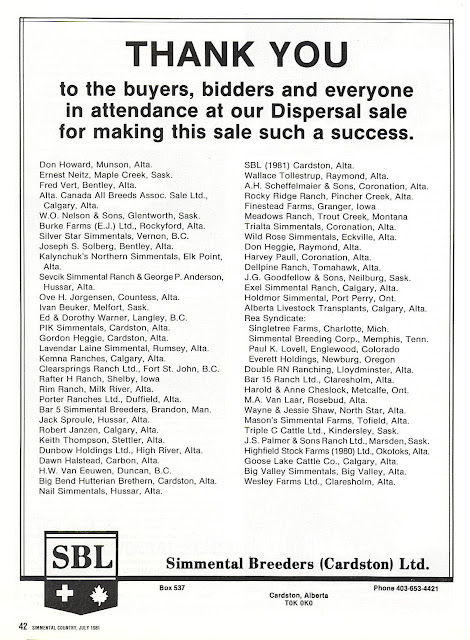History of the Development of SBL’s Cattle Enterprise and Land Acquisition
1966
- Company incorporated
- Import permit granted and Parisien selected
1967
- Parisien imported [i.e., arrived Mt. View, Alberta]
1968
- Four heifers and four bulls imported
- First half-blood calves born
- Curtiss Breeding Service began selling Parisien semen
- Promotional program initiated
1969
- Four heifers and three bulls imported
- Half-blood heifers purchased from Canadian and American ranchers
- Cahoon land purchased
- Parisien on show circuit
- First fullblood calves born—Amor, Apollo and Ami
- Heifer-semen contracts made
- Heninger land rented
1970
- Six heifers and four bulls imported
- Additional half-blood heifers purchased
- Show circuit
- Sale of Amor
- Additional land rented
a) Rothe place
b) Gregson place
c) Bates place
- Additional heifer-semen contracts signed
- Promotional program regarding Lohner semen available through Carnation
- European import selection program initiated
1971
- Four heifers and two bulls imported
- Imported fullblood heifer contracts signed
- More half-blood heifers purchased and gathered under contract
- Sale of fullblood bulls Chief, Cabo and Cy
- Promotion
- Zemp and Beazer land purchased
- Calved first half blood heifer [?–from imported Simmental dam–?]
- Signed contract with A.B.S. for distribution of semen on Beat and Florian
- Eleven fullblood calves born
- Contract for semen distribution on Galant signed with N.B.I.
- Semen contracts on additional bulls signed with Curtiss
- Semen sales peaked as to net earnings
1972
- Eight heifers and two bulls imported
- More half-blood heifers gathered on contract
- Large group of two year old heifers calved—substantial loss due to bad weather
- Jensen land purchased
- More imported fullblood heifer contracts signed
- Twenty-four fullblood calves born
- Forsyth land rented
- Decision made to build an A.I. Stud
1973
- Ten heifers imported
- More imported fullblood heifer contracts signed
- Semen distribution contract signed with Y-Tex
- Simmental sales hit peak
- Farm at Raymond rented
- Fifty-one fullblood calves born
1974
- Two heifers imported
- More imported fullblood heifer contracts signed
- Sixty-nine fullblood calves born
- Semen sales peaked as to number of units sold
- Progeny Test unit purchased
a) land
b) cattle
- More land added to Zemp place
- Construction began on A.I. Stud
- Commercial cattle market weakened
- Simmental sales stayed firm
- Feed costs became prohibitive
1975
- Four heifers imported
- Commenced to phase out European import selection program
- Seventy-seven fullblood calves born
- Universal Semen Sales, Inc set up
- Y-Tex contract terminated
- Simmental sales dropped drastically
- Semen sales plummeted
- SBL cattle inventory peaked
- cash flow very difficult
1976
- Two bulls imported (Abondance*)
- Markets seemed to have bottomed out
- Optimism seems to be coming back
- Drastic cut made in SBL inventory of percentage and progeny test cattle
- Revision of company goal and objectives
- Seventy-three fullblood calves born
This is a reproduction from an SBL list: 1966—1976. Author of list in unknown.
--------------/
* "The French Abondance originated in the harsh conditions of the valleys and mountains of Chablais in the Haute-Savoie. Their bodies are thick and long with strong sound legs and body color is mahogany red with a white face." (quoted from p. 5 of the
Simmental Digest 1992: Simmental Breeders 1992 Special Feature booklet (25th Anniversary of Simmental in Canada).























